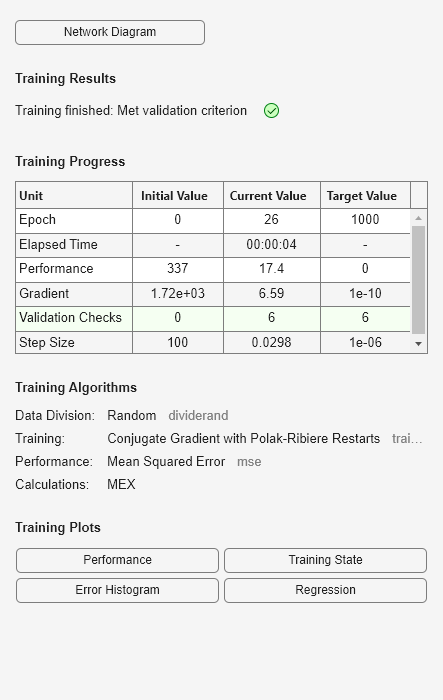traincgp
Conjugate gradient backpropagation with Polak-Ribiére updates
Syntax
net.trainFcn = 'traincgp'
[net,tr] = train(net,...)
Description
traincgp is a network training function that updates weight and bias
values according to conjugate gradient backpropagation with Polak-Ribiére updates.
net.trainFcn = 'traincgp' sets the network trainFcn
property.
[net,tr] = train(net,...) trains the network with
traincgp.
Training occurs according to traincgp training parameters, shown here
with their default values:
net.trainParam.epochs | 1000 | Maximum number of epochs to train |
net.trainParam.show | 25 | Epochs between displays ( |
net.trainParam.showCommandLine | false | Generate command-line output |
net.trainParam.showWindow | true | Show training GUI |
net.trainParam.goal | 0 | Performance goal |
net.trainParam.time | inf | Maximum time to train in seconds |
net.trainParam.min_grad | 1e-10 | Minimum performance gradient |
net.trainParam.max_fail | 6 | Maximum validation failures |
net.trainParam.searchFcn | 'srchcha' | Name of line search routine to use |
Parameters related to line search methods (not all used for all methods):
net.trainParam.scal_tol | 20 | Divide into |
net.trainParam.alpha | 0.001 | Scale factor that determines sufficient reduction in
|
net.trainParam.beta | 0.1 | Scale factor that determines sufficiently large step size |
net.trainParam.delta | 0.01 | Initial step size in interval location step |
net.trainParam.gama | 0.1 | Parameter to avoid small reductions in performance, usually set to
|
net.trainParam.low_lim | 0.1 | Lower limit on change in step size |
net.trainParam.up_lim | 0.5 | Upper limit on change in step size |
net.trainParam.maxstep | 100 | Maximum step length |
net.trainParam.minstep | 1.0e-6 | Minimum step length |
net.trainParam.bmax | 26 | Maximum step size |
Network Use
You can create a standard network that uses traincgp with
feedforwardnet or cascadeforwardnet. To prepare a custom
network to be trained with traincgp,
Set
net.trainFcnto'traincgp'. This setsnet.trainParamtotraincgp’s default parameters.Set
net.trainParamproperties to desired values.
In either case, calling train with the resulting network trains the
network with traincgp.
Examples
More About
Algorithms
traincgp can train any network as long as its weight, net input, and
transfer functions have derivative functions.
Backpropagation is used to calculate derivatives of performance perf
with respect to the weight and bias variables X. Each variable is adjusted
according to the following:
X = X + a*dX;
where dX is the search direction. The parameter a is
selected to minimize the performance along the search direction. The line search function
searchFcn is used to locate the minimum point. The first search direction is
the negative of the gradient of performance. In succeeding iterations the search direction is
computed from the new gradient and the previous search direction according to the formula
dX = -gX + dX_old*Z;
where gX is the gradient. The parameter Z can be
computed in several different ways. For the Polak-Ribiére variation of conjugate gradient,
it is computed according to
Z = ((gX - gX_old)'*gX)/norm_sqr;
where norm_sqr is the norm square of the previous gradient, and
gX_old is the gradient on the previous iteration. See page 78 of Scales
(Introduction to Non-Linear Optimization, 1985) for a more detailed
discussion of the algorithm.
Training stops when any of these conditions occurs:
The maximum number of
epochs(repetitions) is reached.The maximum amount of
timeis exceeded.Performance is minimized to the
goal.The performance gradient falls below
min_grad.Validation performance (validation error) has increased more than
max_failtimes since the last time it decreased (when using validation).
References
Scales, L.E., Introduction to Non-Linear Optimization, New York, Springer-Verlag, 1985
Version History
Introduced before R2006a
